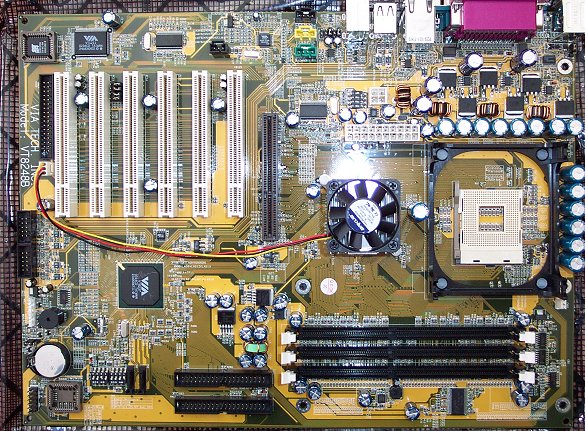Reference look
We'll take a very brief look at the reference PT800 board. As is sometimes the case with pure reference material, the board is larger than the standard ATX format, such that it wouldn't fit into a regular Lian Li PC60 case. Larger PCBs allow the chipset designer to fully explore each and every function.

Reference designs are not always indicative of just how retail boards will appear and perform like. 6 PCI slots, a strange location for the floppy port and dipswitches stand out as idiosyncratic features.

VIA is paying serious attention to the 800FSB-capable North Bridge's cooling. The vast aluminium heatsink and whiny fan are 'features' that we hope not to see on retail boards. Intel have managed to passively cool its boards, boards which often hit 250FSB with consummate ease.

If VIA's chipset dating is correct, the South Bridge was manufactured some time in late April '03. The VT8237 was originally designed to be bolted on to the KT400A, but it's only become truly widespread since the recent launch of the KT600. 2 SATA ports, run off the '8237 and able to provide RAID0 or RAID1 functions, are located close by. We're adamant that a number of motherboard manufacturers will go the whole way and specify the full complement of 4 SATA ports, 2 of which will by run via Silicon Image's chip. Remember that all SATA ports are free from 32-bit PCI bus speed limitations (~132MB/s).
FireWire support would have been most welcome in this instance. VIA, arguably, has the most advanced on-bridge SATA support of any chipset designer, but following on from Intel, VIA has opted to allow manufacturers to specify their own FireWire single-chip solution. The ironic aspect is that VIA's very own VT6306/7 single-chip FireWire designs will be seen on a number of boards.
The BIOS seemed to be lacking in a few areas, especially with respect to hardware monitoring. FSB, though, speeds were adjustable up to 233FSB. We'll focus on BIOSes once we have a number of retail samples to test with.









